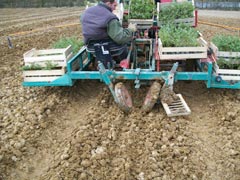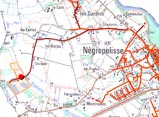The constructed wetland septage treatment plant (CW STP)
Objective
On a site adjoining Nègrepelisse’s wastewater plant and to serve the north-eastern part of the department, CCTVA is constructing for Syndicat Mixte Départemental des Déchets- SMDD a septage treatment plant with a capacity of 11 000 m ³/year or approx. 200 m ³/week to meet the forecasted needs in 20 years.
The treatment process
As regards this new project, CCTVA is keeping to the CW process adopted in 2007 for the communal wastewater treatment plant. The septage will be treated by (from upstream to downstream): a unit of decanting, an aerated storage tank, a constructed wetland, and finally spread on a tree plantation.
Two setups here again:
- Summer setup: the filtrate is spread on a poplar and eucalyptus plantation that entirely absorbs it. Spreading is not practiced during the four or five months of vegetative rest, due to low water consumption during this period.
- Winter setup: the filtrate is treated in the existing ponds of Nègrepelisse’s treatment plant and discharged into the Montrosies stream. The extended circulation period through the ponds (more than 400 days) ensures a good outlet quality.
Download the layout
of Nègrepelisse’s septage treatment plant (82)
The unit of decanting
Transfer of the septage from the emptying trucks to the plant occurs in a special unit comprising a reporting and management station, a transfer point, a collection and storage tank.
An automatic switch identifies the emptying truck, records the origin of its load, takes a sample of the discharged septage and stores this sample for one month under standardised conditions. Unloading is prohibited when the collection tank is full.

Pretreatment
The raw septage remains at least six days in an underground, artificially aerated basin in order to:
- blend the septage of different origins and characteristics
- blend the incoming peak loads and regulate the daily filter inlet volume
- reduce the risk of odours as the septage is discharged on the filters.
Treatment
The septage is treated by the action of bacteria fixed on the gravel and reed roots of a constructed wetland operating along the same principles as the filters of Nègrepelisse wastewater plant, yet with a clearly different layout similar to that of the septage dewatering constructed wetland (the other major application of the constructed wetland system).
Objectives:
- reduce the pollutant loads to levels acceptable for surface spreading and two ponds treatment
- reduce the outlet volumes through evapotranspiration and retention processes.
Spreading on the plantation
 The solution adopted by CCTVA to address the 0 discharge requirement of the Water Authority (no discharge to the river system) consists in spreading the filtrate from the constructed wetland on a tree plantation operated as Short Rotation Coppice -SRC.
The solution adopted by CCTVA to address the 0 discharge requirement of the Water Authority (no discharge to the river system) consists in spreading the filtrate from the constructed wetland on a tree plantation operated as Short Rotation Coppice -SRC.
The filtrate is spread on the plantation by a low-pressure pipe system equipped with an outlet point along each tree trunk.
Trees are "harvested" every seven or eight years by a specifically designed machinery. Within the context of a wood-energy programme, the wood is used in Nègrepelisse collective heating system.
Spreading on plantation
The existing ponds can be used in the septage treatment process in winter when they are not integrated in the Nègrepelisse wastewater treatment plant (because of poor N and P reductions in low-temperature ponds).
